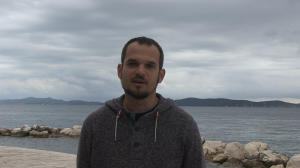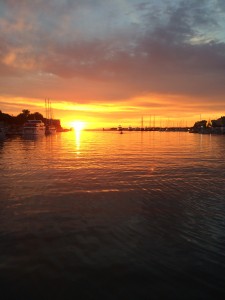On Friday, Anamarija and I met up with one of her former students to discuss his recently completed capstone project. The student, Mihovil Turcinov, developed his project on the history of Brodarica Cove, focusing on the development of community involvement with respect to all the recent changes. I mentioned in a past blog post that these changes were made to accommodate the construction of new buildings and roads. Interestingly, Mihovil’s work became the foundation for why Brodarica Cove was selected as the Zadar LivingLabs site. He spoke about how the local community was against the changes that took place in the cove, which ultimately lead to the destruction of vital natural habitats.
Brodarica Cove was once a thriving area in Zadar. It was a rich estuary with fringing salt marshes that harbored many fish and shellfish populations (including oysters). However, the area was eventually filled and cemented leading to the degradation of these beautiful habitats. In addition, the construction resulted in the input of many pollutants such as lead. The cove now appears as a degraded body of water with high nutrient levels and resulting algal blooms. Now there are practically zero remnants of the natural estuary and salt marshes. Though his interview was done in Croatian, Mihovil later explained his project to me over coffee, which is definitely one of the more common social settings! During coffee, the skies opened up and it began to absolutely downpour.
From that point on we had a rough few days weather-wise. Most of our trip was sunny and hot, but our good fortune seemed to have run out. Zadar doesn’t exactly have active drain systems either and all the rainfall ran off into the harbor and Adriatic directly (this isn’t a good thing for pollution and excess nutrients). Consequently, this made walking anywhere during the storms tricky because much of the roads and sidewalks were flooded with rushing water.
Needless to say, we were delayed with the filming of our final piece – Claudia’s class of student-divers. But on Sunday we had a narrow window that luckily allowed us to drive to Posedarje (15 km from Zadar) to film what she and her students were researching.
The first thing I noticed was that many of these students were older than I am (26) and were still working on their bachelor’s degree. I’m used to seeing a few older students, but a vast majority were in their thirties. Again I’m alluding to the fact that the academic norms here are very different than in the US. Many of these students have full-time jobs and are completing their degree for various reasons relating to their jobs. We first met with the class in a café (see!) to discuss what the task was for the day. After which we all drove to their site at Novigradsko, which is an embayment that connects to the Adriatic Sea. They were all licensed divers and after suiting up they were in the water sampling eelgrass sites to help understand local systems. Their work was a part of the international project ZEN (The Zostera Experimental Network), which “is a global collaborative network of scientists studying the structure and functioning eelgrass (Zostera marina) ecosystem, the world’s most widespread marine plant” (quote from http://zenscience.org/). I enjoyed hearing about their work and it was a nice alternative to the standard form of education and fieldwork that we’re all used to!
At the end of the day (and after the rain subsided) we had a final walk through the city and were incredibly lucky to see an absolutely gorgeous sunset. It wasn’t too bad a way to say goodbye to Zadar!


